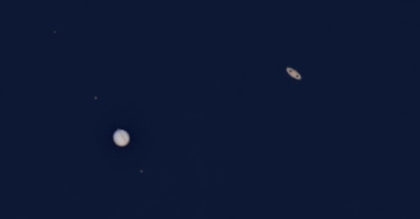
 )
)Reading and writing about The Dance of Life and developemental biology reminded me of the time I was asked to write about a supposed flash of light occurring at the moment of conception. Articles like this one made the rounds on social media, getting everyone excited about a literal spark of life. Or at least I guess that’s what they were excited about; I didn’t really get it because I knew the light came from reagents scientists added to detect zinc and not the egg itself. I appreciated the opportunity to add clarity to the conversation and provide some insight into how science is practiced, but I’m pretty sure some folks felt like I was raining on their parade.
Christmas comes with its own childbirth-associated light, the star of Bethlehem which the magi followed to find Jesus. Days before Christmas this year, we get a conjunction of Saturn and Jupiter causing them to appear as a single, bright star for a short time. This so-called “Christmas star” is one of many astronomical phenomena put forward to explain the magi’s vision. The details of a Jupiter/Saturn conjunction don’t line up for me; Matthew seems to be describing a star that was visible for many nights. But the timing certainly makes it an appealing option, especially this year and especially when so many are looking for something transcendent and hopeful to hold onto.
Particularly around the holidays and for Christians, it might seem like all science does is cast doubt or just flat out take away everything exciting and wondrous and magical about Christmas and faith and maybe even life. Sure, applied science has its merits; you would not be reading this post in this fashion if it weren’t for a number of scientific achievements. At the same time, I sense real disappointment from people who are told the Christmas Star probably isn’t the star of Bethlehem or that human embryos don’t glow. Perhaps the realm of philosophy or theology or more simply of imagination seems to be shrinking. Or perhaps it feels like there are fewer surprises left, because science increasingly has answers.
They could even be disappointed with science itself. They might expect science to tell us what the star of Bethlehem really was. Or to put it a slightly different way, maybe the only sorts of answers that count are scientific ones, or at least ones that can be expressed in scientific language. If that’s the case, how can we think of science as additive rather than subtractive? After all, even if it turns out that the star of Bethlehem was a Saturn/Jupiter conjunction, we can also still correctly say the star of Bethlehem was the guide of the magi and a sign from God announcing the birth of his Son. All of those answers are valid and can be true simultaneously, and the latter two are not made any more or less worthwhile by the first.
We can say the same thing about Psalm 139 and developmental biology. We can simultaneously affirm that God knits each of us, including Jesus, in the womb and that developmental biology reveals some of the cellular and molecular details of how this remarkable process unfolds. Thus, this year I found The Dance of Life to add something to my Advent experience rather than detracting from it. I hope the same is true for you, and I hope you have a blessed and Merry Christmas!
Andy has worn many hats in his life. He knows this is a dreadfully clichéd notion, but since it is also literally true he uses it anyway. Among his current metaphorical hats: husband of one wife, father of two teenagers, reader of science fiction and science fact, enthusiast of contemporary symphonic music, and chief science officer. Previous metaphorical hats include: comp bio postdoc, molecular biology grad student, InterVarsity chapter president (that one came with a literal hat), music store clerk, house painter, and mosquito trapper. Among his more unique literal hats: British bobby, captain’s hats (of varying levels of authenticity) of several specific vessels, a deerstalker from 221B Baker St, and a railroad engineer’s cap. His monthly Science in Review is drawn from his weekly Science Corner posts — Wednesdays, 8am (Eastern) on the Emerging Scholars Network Blog. His book Faith across the Multiverse is available from Hendrickson.

Amen! And a “Merry Christmas!” to you Andy. To God be the glory!